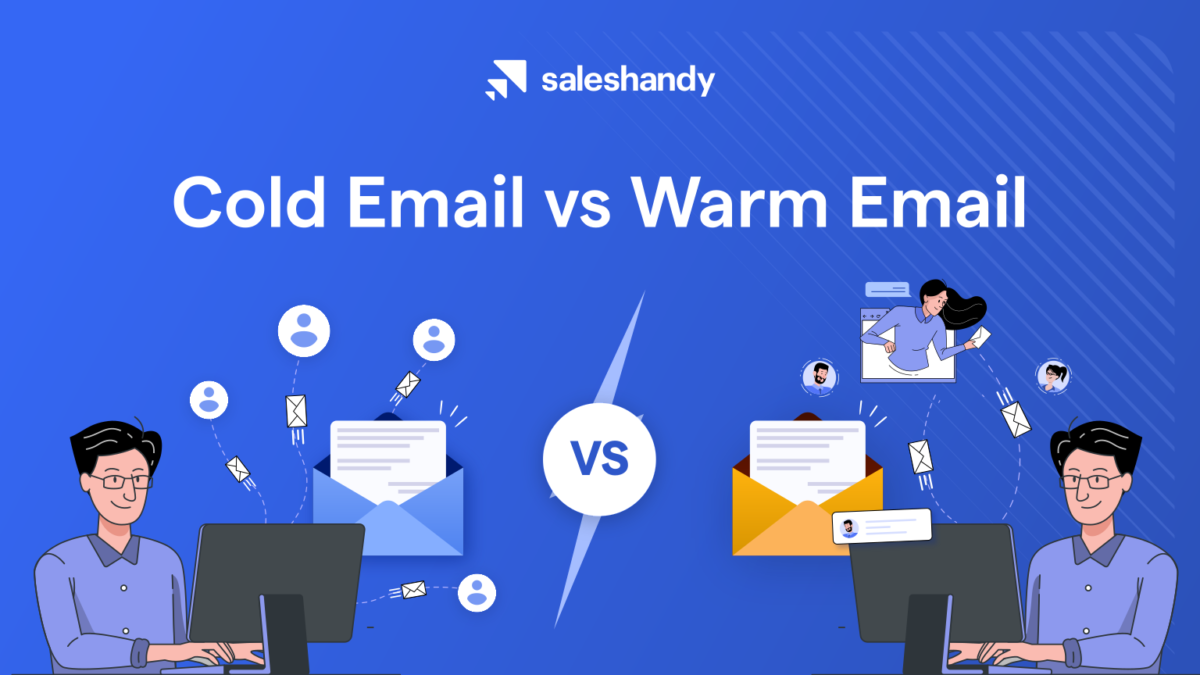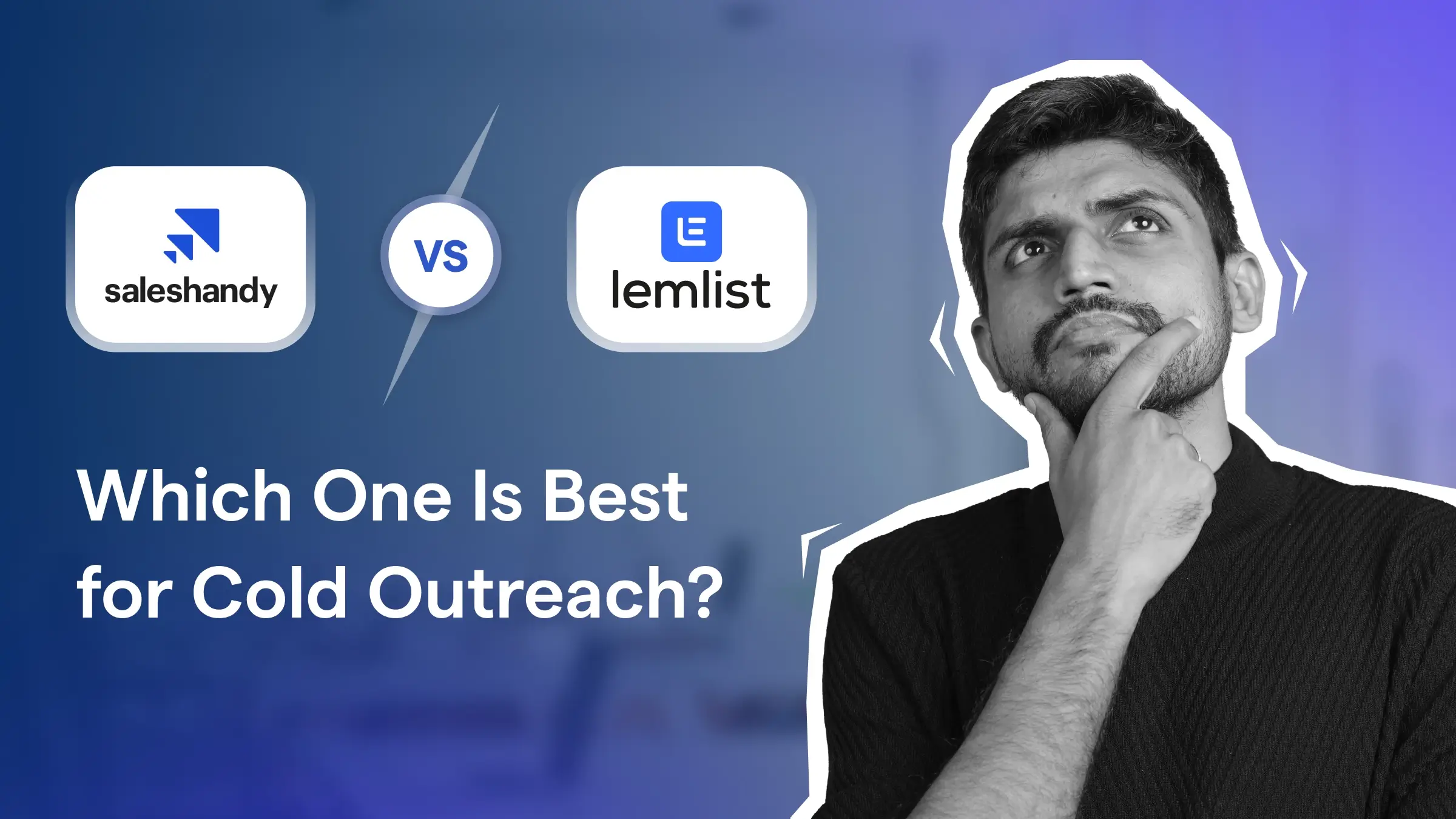Contents
- 1 What is a Cold Email?
- 2 What is a Warm Email?
- 3 What Is The Difference Between Warm Email and Cold Email?
- 4 Advantages & Limitations of Cold Emails
- 5 Advantages & Limitations Of Warm Emails
- 6 Cold Email Vs. Warm Email Examples
- 7 Cold Vs Warm Email: Which is the Best?
- 8 Tips To Write a Good Cold Email
- 9 Conclusion
- 10 FAQs
Confused about choosing between cold or warm email for your business?
To boost prospecting and sales, businesses should leverage both cold and warm emailing. Each has a unique role to play, and together, they create a powerful combination for reaching potential customers.
But if you must choose one, this blog will help you understand what cold and warm emailing are and when to use them correctly.
Okay, let’s dig in.
What is a Cold Email?
Cold email is an outreach practice that allows you to interact with and pitch potential prospects to your business via email.
These prospects are unknown to you and unaware of your existence. So, when you try to build a relationship with them, it is crucial that you make personalized efforts.
The goal is often to introduce yourself, your product, or your service to generate interest and initiate a conversation that could lead to a business relationship.
What is a Warm Email?
Warm email is about connecting with people who have shown some interest in your business by visiting your website, signing up for your newsletter, or doing something similar.
In warm emailing, you have the prospect’s consent to receive email conversation by showing some interest in your product.
Hence, the goal of a warm email is typically to nurture the relationship, provide value, and move the conversation forward in a more personalized and meaningful way.
What Is The Difference Between Warm Email and Cold Email?
| Particulars | Cold Email | Warm Email |
|---|---|---|
| Purpose | Convert prospects into warm leads | Converting warm leads into customers |
| Target Audience | Completely unknown. No consent. | Showed interest and consent. |
| Content | Highly formal, relevant, and personalized | A little personalized, nonformal tone. |
| Level Of Connection | No prior connection | Aware of your existence |
| Risk | High risk of getting marked as spam | Less risky as they showed interest in you. |
| Efforts | More effort to personalize | Use existing info to personalize |
| Challenge | Difficult to convince | Comparatively less difficult |
| Tools To Use | Saleshandy | Hubspot |
Advantages & Limitations of Cold Emails
Let’s discover the pros and cons of using cold emailing for your B2B business.
Advantages of Cold Emailing
- You can send bulk emails to unlimited people to find leads.
- It is cheaper than other marketing and prospecting methods.
- It can be managed by a very small team or even a single person.
- Can be done from anywhere in the world. – No Boundaries
- Can get most of it automated.
Limitations of Cold Emailing
- Need to follow GDPR compliance.
- Need to find the best cold emailing software for quality leads as all tools do not promise a reliable B2B lead database.
- Need a learning curve to draft spam-free cold emails.
But you know, you can solve all these limitations by using a tool like Saleshandy, which provides features like Analytics, 700M+ Lead Database, and Email Personalization.
So, you are only left with the advantages of cold emailing now, which is great news!
Advantages & Limitations Of Warm Emails
Let’s discover the pros and cons of using warm emailing for your B2B business.
Advantages of Warm Emailing
- Great odds for boosting engagement and sparking conversations.
- Effortlessly build and increase brand awareness.
- Lower risk of being flagged as spam.
Limitations of Warm Emailing
- Reliance on current leads.
- Risk of overextending and losing potential prospects.
- Challenging to attract fresh leads.
- Maintaining user engagement can be labor-intensive.
Cold Email Vs. Warm Email Examples
This section will give you cold email vs. warm email examples (templates) that you can use immediately.
To simplify it, we will divide our cold email vs warm email examples use-case-wise. Easy? Let’s see examples now.
A Cold Email Templates
1. For Introduction
Hey {First Name}, I feel we should connect.
Hello, {{First Name}}, Myself {{Name}} and I work with {{Company Name}}. I saw your {{Share social media post}} and realized we share common interests.
I also talk about {{topic}} and share valuable insights too.
Do connect with me by replying to this email or calling me on {Phone Number} if you feel like this excites you.
Thanks For Your Time
{{First Name}}
2. For Offering Services
Hey there {First Name}}, I can help you with {{Pain Point}}
Hey, {First Name}, Glad to connect with you again. I have seen you face {{Pain Point}} since we last connected.
I have {{Mention Experience}} in solving situations like yours for the past 10 years. I feel I can help.
How would you think about hopping on a call? Here is my {{Number}}.
Best regards,
{{First Name}}, {{Company Name}}
3. For Following Up
I guess you missed my message, {First Name}
Hope you are having a good day, {First Name}. I just saw you struggling with the same {{Mention issue }} a few days back. And, you also struggled recently in {{any new issue}} too!
I would just like to remind you that my offer to connect on the same is still open in case you missed my last email.
Here is my {{Contact details}}. Let’s get on a call soon!
Regards,
{First Name}
A Warm Email Templates
1. For Introduction
Hey {First Name}, Nice connecting with you.
Hello there {First Name}.
Welcome to the {{Company Name}}’s email list. We realized you just signed up for our newsletter. Great choice!
You can expect updates, new blogs, and similar conversations from our weekly newsletter.
Once again, thank you for joining the {Company Name} tribe.
Regards,
{{First Name}}
2. For Offering Services
3. For Following Up
You missed it, {{First Name}}!
You really want to invest in good things, right? We know you were checking our product again!
We see you missed our last email regarding {{State the offering}}, {{First Name}}. We would love to connect with you to help make that long pending decision.
We have some new updates as well. Check it here {{Link}}.
Many Thanks,
{{First Name}}, {{Position}}
Cold Vs Warm Email: Which is the Best?
You can choose either cold emailing, warm emailing, or a combination of both based on your specific requirements.
For many businesses, the battle between cold and warm emails is a tie. If you’re unsure which to choose, read the points below to help you decide.
Cold emailing is better for you if,
- You are targeting ICPs,
- Generating new B2B leads,
- Need to start a bulk email campaign or design a systematic drip campaign,
- You want to highlight the unique value proposition of your products or services,
On the other side, warm emailing can be good for you if,
- You want to go ahead with lead generation from prior connected prospects only
- The main purpose of your lead gen is re-engagement,
- You do not want to make an initial contact and just follow up with the incoming leads
Tips To Write a Good Cold Email
1. Personalization
Cold emailing, to be successful, needs to be highly personalized. Because one of the main reasons why most cold emails land in spam folders is because it is not addressed to an individual.
Tools like Saleshandy allow you to personalize your emails. It offers features like Merge tags, Spintax, HTML content, A/B testing, and more to ensure that your email appears as if written by an individual.
Ultimately, you can even test your emails to ensure they are error-free before sending them to the masses.
2. Focus On The Subject Line
Here are a few things that you should follow while writing subject lines for your cold emails.
Your cold subject lines should be short, relevant, personalized, and spam-free.
Check here to learn more about how an ideal cold email subject line should be.
3. Pre-Header
The preheader is a small one-liner visible below your subject line. This line is crucial as it lets readers understand the content and get excited to open your email.
People also use pre-headers as a connecting sentence to their subject line. This creates an additional layer of excitement in the user’s mind for the actual content.
Pre-headers are also almost the same length as a subject line, so all the guidelines we learned about that apply here as well.
4. Short CTA
Many people neglect the importance of giving the readers an action item after writing the whole email. In email terms, this is known as a “Call to Action.”
Email is only good when it is conversational. Now, by conversing, it does not mean they should reply to your email only.
They can show their interest by clicking on your CTA, indicating that they want to know more about your business.
An ideal CTA is 3 to 5 words maximum. If you can keep it under 3 words, then it works the best. Your CTA should also be inviting and clear enough.
5. Email Content Under 100 Words
The content of your email is another way to ensure that your prospects open your email next time.
The recommendation is to introduce yourself in the first 2 lines. Then, jump to the purpose of the email in the next section and end it with a clear CTA for the readers.
Doing this ensures you are not boring your prospects and increasing your chances of getting the message across.
Don’t get overwhelmed. Saleshandy helps you check subject line scores, spintax for personalization, and an AI writing assistant to guide you while drafting your email. Trust me, it’s super easy!
Bonus Tip: Using the Best Cold Email Automation Tool
Saleshandy is one of the best tools in the cold email automation domain. It can solve all your pain points in one go. Which ones? Let me tell you.
Saleshandy offers features like Email warm up, sequence score, sender rotation, AI writing assistant, Email personalization, b2b lead finder, Email automation, and many more.
With features like A/Z testing, you can test and see how your emails are performing what your readers are engaging with, and plan follow-up emails. Everything in one tool.
Conclusion
At the end of this cold vs warm email talk, as a crux of the whole thing, it is safe to say that warm email is for you if you already have a set of audiences interested in receiving email communications from you.
But if you are trying to find targeted prospects using the advanced filters that directly land your email to your ICP, then cold emailing works the best!
FAQs
1. What is the difference between warm and cold outreach?
The main difference is consent. In warm emailing, the prospects have an idea about you. Either way or another, they have consented and said they are fine with you connecting with them.
But in cold emailing, you send emails to people who do not know about you. Hence, getting help from tools like Saleshandy becomes crucial to ensure you do it right!
2. What points should you remember while writing a warm email?
A warm email is your first interaction with potential customers, so make sure it is personalized and well-written and that it helps them recognize your brand from your words. This will ensure they open your email in the future.
3. What is the difference between cold and warm leads?
Cold leads are people who don’t know about your existence. On the other hand, warm leads are people who are aware of your business and have shown some interest.
It can be done by visiting your website, signing up for your newsletter, downloading your free resource, or doing something similar.
4. What is a warm email list?
A warm email list lists people who have shown interest in your product/service. This interest is shown by visiting your website, downloading your free material, signing up for your newsletter, or doing a similar activity.
By doing this, the user suggests that they are interested in you, allowing you to add them to your warm email list.







